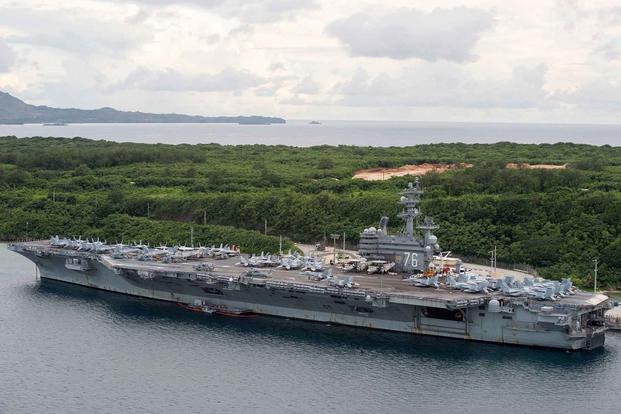The U.S. must upgrade defensive systems in Guam to protect Americans -- including a growing number of troops and military equipment there -- from the threat of Chinese missiles, the head of U.S. Indo-Pacific Command said this week.
Adm. Phil Davidson said installing a new 360-degree air-defense system in Guam would allow at least three Navy ships to take on other missions in the region. Navy destroyers equipped with a system that can search for and track incoming threats currently operate nearby to protect the U.S. territory.
"We need to free up those guided-missile destroyers that have multi-mission capabilities to detect threats -- and finish threats -- under the sea, on the sea, and above the sea," Davidson said Thursday during a virtual event hosted by the American Enterprise Institute.
Read Next: Republicans Call on Biden to Boost Pentagon Spending to Combat China
The admiral delivered to Congress this week an investment plan for the massive region in which he oversees military operations. That plan includes a pitch for a $1.6 billion investment for a new Guam defense system. That includes spending $350 million to start the project in fiscal 2022, according to the report's executive summary.
Davidson called funding for the air-and-missile defense of Guam his No. 1 priority. Even with Navy destroyers combined with the Terminal High-Altitude Area Defense system in Guam now, the systems are no match for missile threats from China, he said.
They don't provide 360-degree defense, he explained, leaving them more suited for defending against a rogue shot from North Korea than the more advanced missile threats from China.
"There are 170,000 Americans living in Guam, and their defense is homeland defense," he said, adding that about 22,000 service members, civilian contractors and military family members are based on the tiny island in the Western Pacific.
The number of personnel will only increase, he added. The U.S. is investing billions to make Guam a major hub for military operations in the Asia-Pacific region.
The Marine Corps in October activated Camp Blaz in Guam, the first new base for the service in the Pacific since the 1950s. About 5,000 Marines are slated to relocate there from Japan in the next five years.
Now, Davidson said, the military needs to protect those assets.
"We must evolve the critical defense of our people, our platforms and our posture initiatives, and it begins in Guam," he said.
Putting a new air-defense system in Guam won't make the island a target, Davidson said, because it already is one. He cited a video the Chinese air force released in September depicting one of its long-range bombers carrying out a simulated missile strike in Guam.
"What the Chinese are showing you, not only in video, but in deployments in the region with circumnavigations of Guam and the commonwealth and the Northern Marianas with surface ships, with bomber runs in the Philippines Sea, and submarines ... around those areas means there's a 360-degree threat," Davidson said.
China seeks a new world order, he added -- one in which "Chinese national power is more important than international law."
Military leaders have warned that the investments China has pumped into building up its military in recent years could leave the U.S. outmatched in the region within a decade. Former Navy Secretary Kenneth Braithwaite described his concerns over China this way in October: "What we are seeing emerging is a threat beyond any comparison ever in the history of our country."
Defense Secretary Lloyd Austin, in a memo issued to the force Thursday, lists developing plans and capabilities to deter China as a top military priority.
Davidson said China could "achieve overmatch" in the region as soon as 2026.
-- Gina Harkins can be reached at gina.harkins@military.com. Follow her on Twitter @ginaaharkins.
Related: SecNav Says China Poses 'Threat Beyond Any Comparison' to American Way of Life














